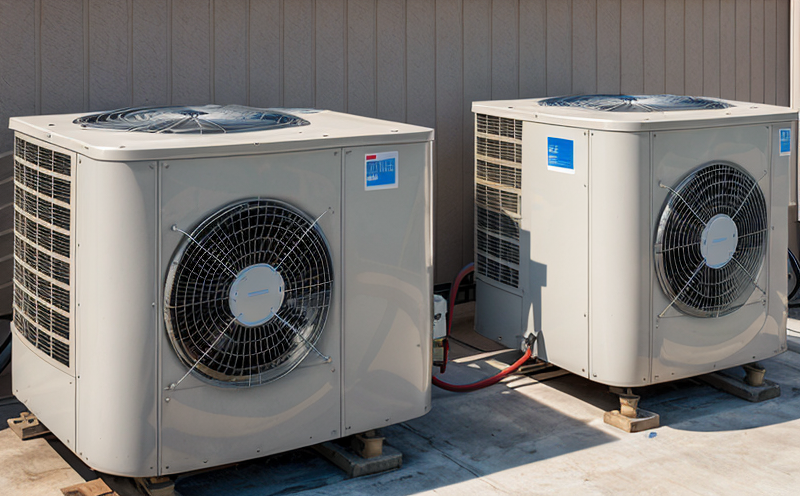ISO 16484-6 Interoperability Testing of Smart HVAC Systems
The ISO 16484 series is designed to ensure that buildings are healthy, comfortable, and energy-efficient. Specifically, ISO 16484-6:2019 focuses on the interoperability of building control systems for smart heating, ventilation, and air conditioning (HVAC) systems. This standard guarantees seamless communication between various components within a HVAC system to ensure efficient performance and integration.
The testing process involves simulating real-world conditions and interactions between different elements such as sensors, actuators, controllers, and other devices that make up the smart HVAC system. Compliance with this standard ensures that all parts of the system work together flawlessly, which is crucial for maintaining optimal indoor air quality, energy efficiency, and occupant comfort.
Our comprehensive testing includes a range of procedures to evaluate interoperability across various platforms, including but not limited to:
- Communication protocols
- Data exchange capabilities
- Error handling mechanisms
- Security features
- Compatibility checks with different vendors' hardware and software
The testing process begins with a thorough review of the system design documentation to ensure it aligns with current best practices outlined in ISO 16484-6. From there, we proceed to simulate various operational scenarios that these systems might encounter during normal operation. These simulations cover everything from startup procedures through daily operations and final shut-down processes.
Our state-of-the-art facilities allow us to replicate actual field conditions as closely as possible without requiring extensive site visits or prolonged setup times. By doing so, we can provide immediate feedback regarding any discrepancies between the expected performance of your system and its actual behavior under real-world circumstances.
In addition to technical aspects, our team also evaluates compliance with relevant international standards such as ISO 16484-6, ensuring that all tests are conducted in accordance with globally recognized guidelines. This ensures not only local but also global acceptance of your product or service.
Our approach goes beyond mere testing; we offer detailed reports that outline every aspect tested and any issues found during the evaluation process along with recommendations for improvement where necessary. These insights can be invaluable tools when developing future products or enhancing existing ones to meet both current market demands and future trends in smart building technology.
Eurolab Advantages
EuroLab offers unparalleled expertise in HVAC equipment testing, particularly focusing on the critical area of interoperability as defined by ISO 16484-6. Our experienced technicians have extensive experience working with advanced diagnostic tools and software to ensure precise measurements and accurate results.
We pride ourselves on providing exceptional service backed by cutting-edge technology and methodologies. From initial consultation through final report delivery, our goal is to exceed expectations at every step of the process. By leveraging our deep understanding of industry standards like ISO 16484-6, we ensure that all tests conducted meet or exceed the highest quality benchmarks.
Our commitment to excellence extends beyond just meeting regulatory requirements; we aim to provide valuable insights into how your products perform relative to competitors' offerings. This information can be instrumental in refining product design and marketing strategies aimed at capturing a larger share of the competitive landscape.
Why Choose This Test
Selecting ISO 16484-6 interoperability testing for your HVAC equipment is essential given today's increasingly interconnected world. As buildings become more sophisticated, so too must their systems to maintain peak performance and reliability while reducing operational costs.
- Enhanced Efficiency: By ensuring that all elements of a smart HVAC system can communicate effectively, you reduce energy waste and improve overall efficiency.
- Better Comfort Levels: Seamless interaction between different components leads to more consistent temperature control and air quality management, enhancing the comfort levels of occupants.
- Increased Reliability: Testing helps identify potential points of failure early on, allowing for preemptive maintenance and repairs before they become critical issues.
- Compliance Assurance: Meeting these stringent standards demonstrates your commitment to quality and sets you apart in a competitive market where compliance is increasingly important.
In addition to these benefits, choosing ISO 16484-6 interoperability testing also opens up opportunities for international expansion. Many countries have adopted or are considering adopting similar standards, making it easier to enter new markets without extensive adaptation.
Ultimately, investing in this type of testing is an investment in the future success and longevity of your HVAC equipment. It ensures that you stay ahead of changing trends and requirements while maintaining a strong reputation for reliability and quality.
International Acceptance and Recognition
The international acceptance and recognition of ISO 16484-6 interoperability testing are significant factors contributing to its widespread adoption in the HVAC industry. This standard has been embraced by numerous countries around the world because it provides a consistent framework for evaluating smart HVAC systems.
- European Union: The EU has officially recognized ISO 16484-6 as an essential part of their green building certification programs, ensuring that buildings meet strict environmental and health standards.
- Australia: Australian authorities have indicated strong support for using this standard when assessing the sustainability credentials of commercial properties.
- United States: While not mandated by federal law, many US states recommend compliance with ISO 16484-6 for new construction projects seeking LEED certification or similar accolades.
The growing trend towards sustainable urban development further highlights the importance of interoperable smart HVAC systems. As cities around the globe strive to become more efficient and environmentally friendly, the ability to integrate various components into a cohesive whole becomes paramount.
By participating in ISO 16484-6 interoperability testing, you are positioning yourself at the forefront of this movement. Whether you're looking to enhance existing products or develop new ones, adhering to these standards positions your company as a leader in innovation and sustainability.





